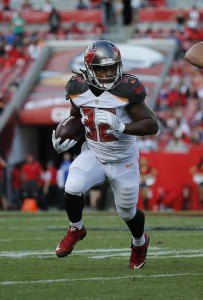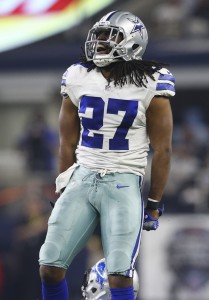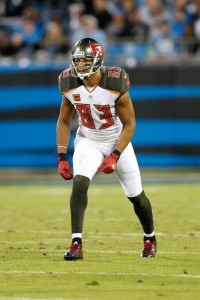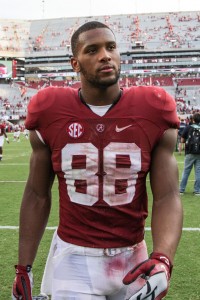Last year’s Buccaneers didn’t break the club’s decade-long streak of sitting at home during the postseason, but they did post their best record since 2010. Under first-year head coach Dirk Koetter, quarterback Jameis Winston showed marked improvement, while Tampa Bay’s defense also posted better results under new coordinator Mike Smith. With an eye towards earning a playoff berth for first time since the Jon Gruden era, the Buccaneers entered the offseason with clear goals in mind.
Notable signings:
- DeSean Jackson, WR: Three years, $33.5MM. $20MM guaranteed.
- William Gholston, DE: Four years, $27.5MM. $7MM guaranteed. $9MM available via incentives.
- Chris Baker, DT: Three years, $15.75MM. $6MM guaranteed.
- J.J. Wilcox, S: Two years, $6.5MM. $3.125MM guaranteed.
- Josh Robinson, CB: Two years, $5MM. $3MM guaranteed.
- Chris Conte, S: Two years, $5MM. $2.5MM guaranteed.
- Ryan Fitzpatrick, QB: One year, $3MM. $1.25MM guaranteed. $2MM available via incentives.
- Joe Hawley, OL: Two years, $6MM. $1MM guaranteed.
- Nick Folk, K: One year, $1.75MM. $750K guaranteed.
- Jacquizz Rodgers, RB: Two years, $3.3MM. $600K guaranteed.
- Sealver Siliga, DT: One year, $1.1MM. $200K guaranteed.
- Garrison Sanborn, LS: One year, minimum salary benefit. $50K guaranteed.
- Ryan Griffin, QB: One year, $1.797MM. Signed original round RFA tender.
- Jacquies Smith, DE: One year, $1.797MM. Signed original round RFA tender.
- Robert McClain, CB: One year, minimum salary benefit.
- Justin Trattou, DE: One year, minimum salary benefit.
- Marqueston Huff, S: One year, $690K.
- Tavaris Barnes, DE: One year, $540K.
While the Buccaneers passing offense ranked a respectable 12th in DVOA last season, the unit didn’t post many explosive plays, as Tampa Bay finished 24th in 20+ yard receptions and dead last in 40+ yard catches. Mike Evans, Adam Humphries, and Cameron Brate formed the foundation of a solid passing game, but a new dimension was clearly needed. Enter DeSean Jackson, who lead the league in yards per reception in 2016, the third time he’s done so in his nine-year career. Among receivers with at least 40 receptions last season, Jackson ranked third with 12.82 air yards per catch, meaning he’s able to get open down the field and not simply rely on yards after the catch. He also accounted for 145 yards and four first downs by drawing pass interference penalties, an underrated facet of his game. Although he’s on the wrong side of 30, Jackson is exactly what the Buccaneers offense needs, and he should be worth of every penny of a contract that makes him the ninth-highest-paid wideout in the NFL.
Joining Jackson as an offensive starter (at least for the first three games of the season) will be running back Jacquizz Rodgers, who earned the first multi-year contract of his career after averaging 4.3 yards per carry on 129 rushes a season ago. Rodgers, 27, touched the ball more than he had in any prior season, and was a workhorse for Tampa Bay in Weeks 5-7, rushing the ball 75 times during that span. He’ll be the Buccaneers’ lead back to begin the campaign while Doug Martin finishes a suspension, and Rodgers could keep the starting job for even longer, as general manager Jason Licht recently indicated Martin won’t be handed a role when he returns.
While the Bucs are comfortable rolling with Rodgers until Martin comes back, they surely won’t feel the same way if they’re forced to use new backup quarterback Ryan Fitzpatrick for any extended period of time. That being said, Fitzpatrick isn’t a disaster as a reserve option, especially at a price of only $3MM. Yes, Fitzpatrick posted the worst statistics of any starting quarterback not named Matt Barkley or Jared Goff in 2016, but he’s not being asked to start in Tampa Bay. If Jameis Winston is sidelined next year, Fitzpatrick should at least be able to keep the club’s offense afloat.
On defense, the Buccaneers acted quickly to re-sign defensive end William Gholston, who was said to be a priority for the team in free agency. At first glance, Gholston’s five-year contract appears to be a massive overpay, as his $5.5MM annual salary is exorbitant for a run-stuffer who ranked as a bottom-20 edge defender in 2016, per Pro Football Focus. But because Tampa Bay rarely employs signing bonuses, Gholston’s deal is essentially a one-year pact. All of his $7MM guarantee comes in 2017, and the Buccaneers could cut ties after the season without any dead money incurring on their cap. If Tampa is able to land a top-notch pass rusher in next year’s draft, I’d expect Gholston to be on the chopping block.
New defensive tackle Chris Baker will be lining up next to Gholston after the Bucs lured him away from the nation’s capital with a three-year agreement, and he should be able to help out a Tampa Bay run defense that took a major step backward under first-year defensive coordinator Mike Smith. While the Buccaneers’ pass defense improved from 26th in DVOA to sixth, the club’s prowess against the run slipped from ninth in DVOA to 26th, while Tampa’s defensive line ranked 24th in adjusted line yards. Baker is a stud in the run game, but he’s also adept at getting after opposing quarterbacks, as he ranked 11th among defensive tackles with 16 hurries last season.
Chris Conte keeps getting chances despite grading as one of the least capable safeties in the league for the duration of his career. Last season, PFF ranked Conte as the second-worst safety in the NFL, but the Buccaneers still re-signed him to a two-year pact. Thankfully, Tampa Bay isn’t asking Conte to play a full complement of snaps in 2017, as they’ve signed former Cowboy J.J. Wilcox and drafted Justin Evans in the second round. Wilcox, 26, only played half of Dallas’ defensive snaps a season ago, but had significant starting experience in 2014-15. Josh Robinson is back to help out in the secondary, as well, but most of his time will be spent as a gunner on special teams.
Tampa Bay signed kicker Nick Folk to hedge against Roberto Aguayo‘s struggles, and the move now seems prescient following Aguayo’ release. Although Tampa handed Folk a $750K guarantee, the club was only nominally on the hook for that money — had Folk been cut, he likely would’ve been picked up by another team, and the offset language in his deal would have freed the Bucs from his commitment. The Jets, Folk’s former employer, ranked dead last in special teams DVOA last season, but that wasn’t Folk’s fault, as he converted 87.1% of his kicks (including 50% from 50+ yards) and gave New York 0.3 points of field position. He didn’t do well on kickoffs, however, as he ranked just 23rd among kickers with 39 touchbacks.
Notable losses:
- Roberto Aguayo, K: Waived
- Gosder Cherilus, T: Retired
- Andrew DePaola, LS
- Mike Glennon, QB
- John Hughes, DT
- Vincent Jackson, WR
- Howard Jones, DE: Non-tendered
- Bradley McDougald, S
- Brandon Myers, TE
- Russell Shepard, WR
- Cecil Shorts, WR
- Daryl Smith, LB
- Akeem Spence, DT
- Antone Smith, RB
- Alterraun Verner, CB: Released
While the Buccaneers are losing a number of offensive players in Vincent Jackson, Russell Shepard, Cecil Shorts, and Brandon Myers, it’s difficult to say the club will miss any of them all that much, as that foursome combined for only 20% of Tampa Bay’s targets in 2016. Shepard led the group with 40 targets and 23 receptions, and he’s the only one that’s landed a new contract (with the division rival Panthers). The Buccaneers signed DeSean Jackson to replace Shepard, who ranked a below-average 65th among wideouts with at least 40 targets with a 57.5% catch rate.
Although Jackson hasn’t yet found a new home, he’s given no indication that he plans to retire. Now 34 years old, Jackson played out the entirety of his five-year deal with the Buccaneers, and though he was extremely productive during the first three seasons of the pact, injuries wrecked his 2015-16 campaigns. As of March, Jackson planned to continue his career, and while it doesn’t appear he’s a candidate to re-sign with Tampa Bay, it’s possible he could find a contract as the regular season approaches, although it may require a team suffering an injury on their wide receiver depth chart.
Mike Glennon meshed with Jackson back in 2013, helping the veteran receiver 78-catch, 1,200+ yard season — but in the next three years, Glennon managed only 214 pass attempts as the Buccaneers instead turned to Josh McCown and Jameis Winston. Entering his age-27 season, Glennon clearly wanted to hit the open market and find a starting job (although it’s unclear if he’ll actually get that opportunity with the Bears). But Tampa didn’t let Glennon go without a fight: the club made numerous attempts to re-sign Glennon, and even offered him to make him the league’s highest-paid backup quarterback with an annual salary of $8MM.
On the other side of the ball, the Buccaneers parted with ways with two defensive backs, allowing safety Bradley McDougald to leave via free agency while releasing cornerback Alterraun Verner. The decision to cut ties with Verner was the correct one, as he was barely contributing on defense and was scheduled to carry a $6.5MM cap charge in 2017. But Tampa might have considered retaining McDougald, who is still only 26 years old and signed for just one year with Seattle. The Buccaneers essentially chose J.J. Wilcox, and while PFF assigned Wilcox a higher grade, McDougald had a much larger sample size (nearly double the snaps).
Tampa has used draft choices on linebackers in each of the past two seasons (Devante Bond in 2016 and Kendell Beckwith in 2017), meaning there was no role for veteran Daryl Smith. Smith, now 35, played a two-down role for the Buccaneers last season, playing 45% of the club’s defensive snaps behind Lavonte David and Kwon Alexander. Given his age and his mediocre performance, Smith has probably hit the end of the line, and if so, he’s posted an excellent career. He started 184 games over 13 seasons, and ranks as the 11th-most valuable member of the 2004 draft class by Pro Football Reference’s approximate value metric.
The Buccaneers’ most recent notable transaction was waiving kicker Roberto Aguayo, whom the club infamously selected in the second round of the 2016 draft after trading 132 cents on the dollar to move up. The choice wasn’t defensible at the time, as Justis Mosqueda of Setting the Edge recently detailed Aguayo’s collegiate struggles from 40+ yards should dissuaded Tampa Bay from drafting the Florida State product. But good on general manager Jason Licht for admitting his mistake and cutting his losses. Even better, the Bears curiously claimed Aguayo off waivers, clearing his partially guaranteed base salary from the Bucs’ 2017 books.
Trades:
- Acquired a 2017 third-round pick (No. 107; LB Kendell Beckwith) from the Jets in exchange for a 2018 fourth-round pick (No. 125) and a 2017 sixth-round pick (No. 204; CB Derrick Jones).
- Acquired a 2017 seventh-round pick (No. 223; DT Steve Tu’ikolovatu) from the Dolphins in exchange for a 2017 seventh-round pick (No. 237; WR Isaiah Ford) and a 2018 seventh-round pick.
Draft picks:
- 1-19: O.J. Howard, TE (Alabama)
- 2-50: Justin Evans, S (Texas A&M)
- 3-84: Chris Godwin, WR (Penn State)
- 3-107: Kendell Beckwith, LB (LSU)
- 5-162: Jeremy McNichols, RB (Boise State)
- 7-223: Steve Tu’ikolovatu, DT (USC)
Just seven tight ends have been selected in the first round over the past ten years, and only Eric Ebron — chosen 10th overall in 2014 — was picked higher than O.J. Howard. The Buccaneers, of course, already boast one excellent tight end in Cameron Brate, who finished fourth in DYAR last season while leading all tight ends with eight receiving touchdowns. Tampa Bay ran two tight end sets on 23% of its offensive plays in 2016 (7% above league average), and the percentage figures to increase during the upcoming campaign. Howard will likely begin his career as an in-line tight end, as Jenna Laine of ESPN.com reports he’s already made a “noticeable difference” with his blocking.
Left tackle Donovan Smith, particularly, needs all the help he can get, as the Buccaneers ranked 24th in adjusted line yards when running towards the left tackle and 26th when running around the left end. Because Smith has struggled so much through two NFL seasons (No. 65 tackle in 2016, per PFF), it’s fair to wonder why Tampa Bay didn’t consider an offensive lineman such as Garret Bolles or Cam Robinson with the No. 19 selection. Jameis Winston took the most hits of any quarterback last season (87), per the 2017 Football Outsiders Almanac, and protecting their young quarterback should be the Buccaneer’s top priority. However, Winston posted the third-best DVOA against pressure last year, according to Scott Kacsmar of Football Outsiders, so perhaps Tampa doesn’t feel investing in its offensive line is all that important.
Second-round safety Justin Evans could end up playing the most snaps of any Buccaneers rookie, as he’s currently projected to start in the back end (although Keith Tandy could have something to say about that). Chris Godwin — whom Matt Harmon of Perception Reception fame called the draft’s most underrated receiver — and Jeremy McNichols will likely begin their careers pushed down the offensive depth chart, but injuries could allow them playing time as the season progresses. Kendell Beckwith is still recovering from a torn ACL and could potentially “redshirt” during his rookie season. Steve Tu’ikolovatu is huge and (relatively) old.
Extensions and restructures:
- J.R. Sweezy, G: Restructured contract. Converted 2017 $2.5MM base salary and $2.5MM roster bonus to $3.75MM base salary, with $1.25MM available via incentives. Base salaries reduced in 2018-20.
Other:
- Extended defensive coordinator Mike Smith.
- Exercised 2018 fifth-year option for WR Mike Evans ($13.258MM).
- Learned CB Jude Adjei-Barimah will miss 2017 season (patellar fracture).
- Signed 14 undrafted rookie free agents.
The Buccaneers’ decision to exercise Mike Evans‘ 2018 option was a complete formality, so let’s use this space to toss out some Evans stats. Since 1970, Evans is fifth among three-year receivers in receiving yards, sixth in receptions, and seventh in touchdowns. In 2016, he was especially proficient, as he reduced his drop percentage from 7.4% in 2015 to just 4.1%. He ranked sixth in DYAR, and was one of only two pass-catchers to post a PFF grade over 90.0 (the other being Julio Jones). Evans was also particularly clutch, as he lead the NFL with 80 receptions that went for a first down or touchdown (29 of those came on third or fourth down, also tops among wideouts). Did we mention that he doesn’t turn 24 until next week?
Top 10 cap charges for 2017:
- Gerald McCoy, DT: $13,750,000
- DeSean Jackson, WR: $12,500,000
- Brent Grimes, CB: $8,000,000
- William Gholston, DE: $7,000,000
- Doug Martin, RB: $7,000,000
- Jameis Winston, QB: $6,913,985
- Robert Ayers, DL: $6,250,000
- Chris Baker, DT: $6,000,000
- Lavonte David, LB: $6,000,000
- Mike Evans, WR: $4,655,478
Although the NFC South boast the conference champion, the division appears wide open — ESPN’s Football Power Index projects each team in the NFC South to win between 7.7 and 9.3 games. The Buccaneers are at the bottom of the projected divisional standings, but there’s no reason they can’t compete for the division title or — at the least — a wild card slot.
Information from Over the Cap and Roster Resource was used in the creation of this post. Photos courtesy of USA Today Sports Images.